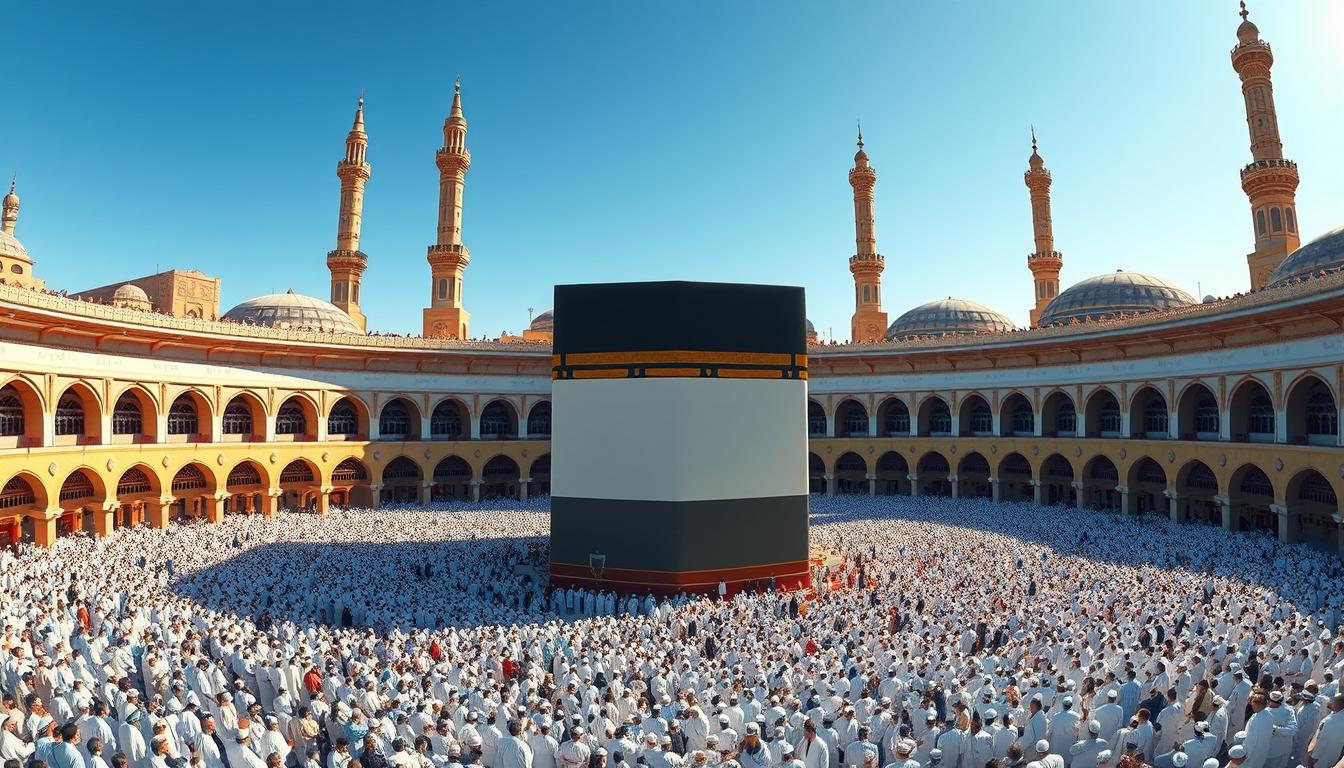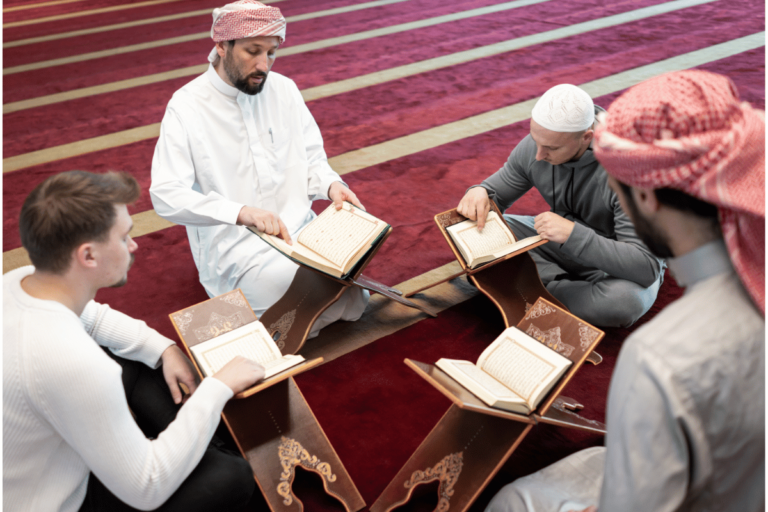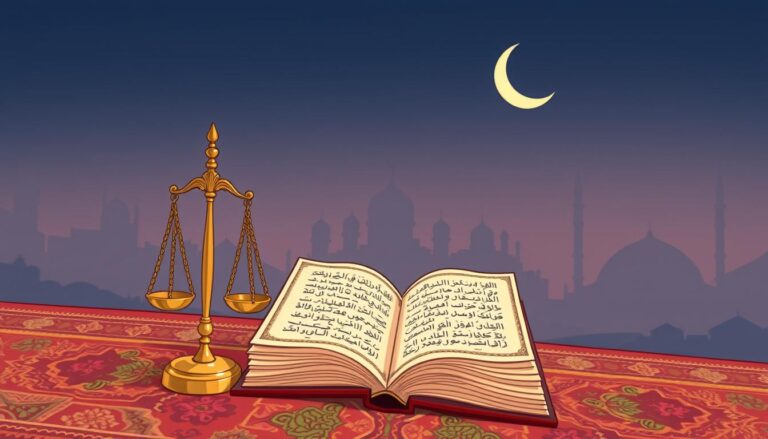A Beginner’s Guide to Hajj: What You Need to Know
Have you ever wondered why millions of Muslims go to Mecca each year? The hajj pilgrimage is a key part of Islamic faith. It calls believers from all over to join in a deep act of worship. This guide will show you the heart of this sacred journey, its spiritual value, and how to prepare.
The hajj happens in the 12th month of the Islamic calendar. It’s a journey every able-bodied Muslim with enough money must take once. The journey focuses on the Kaaba, a special stone building in Mecca’s Grand Mosque. It’s believed to have been built by Prophet Abraham and his son Ishmael.
When pilgrims wear the Ihram, two white pieces of cloth, they become spiritually pure. The hajj lasts five days, filled with important rituals. These include circling the Kaaba, running between hills, and praying on Mount Arafat. Each part of the journey has deep meaning, offering a chance for renewal and forgiveness.
Key Takeaways
- Hajj is a mandatory pilgrimage for able-bodied Muslims with financial means
- The pilgrimage occurs annually from the 8th to the 13th of Dhul Hijjah
- Pilgrims enter a state of Ihram, wearing specific clothing and following certain prohibitions
- Key rituals include Tawaf (circling the Kaaba) and Sa’i (running between Safa and Marwa)
- The Day of Arafat is considered the most significant day of Hajj
- Hajj is believed to wipe away all sins if performed correctly
- There are three types of Hajj: Tamattu, Qiran, and Ifrad
Understanding the Significance of Hajj in Islam
Hajj is a key part of Islamic faith, a deep spiritual journey. It’s one of the most important religious duties. Millions of Muslims go to Mecca each year to take part in its sacred rituals.
The Five Pillars of Islam
Hajj is among the Five Pillars of Islam. The others are declaring faith, praying, giving to charity, and fasting. Hajj is special because it’s only needed once in a lifetime for those who can.
People must have money and be physically able to go. It’s a big commitment for Muslims.
Spiritual Benefits of Hajj
The journey of Hajj brings great rewards. Many see it as a chance for rebirth and renewal. During Hajj, Muslims focus on their bond with God, seeking forgiveness and personal growth.
The shared experience of Hajj also brings Muslims together. It shows the unity of diverse Muslim communities.
Historical Context of Hajj
Hajj goes back to Prophet Abraham’s time, making it very significant. Pilgrims follow the path of prophets, remembering important moments in Islamic history. The rituals of Hajj, like circling the Kaaba and running between hills, connect modern Muslims to their spiritual ancestors.
“Hajj is a powerful reminder of our shared humanity and the equality of all believers before God.”
Understanding Hajj’s deep meaning helps Muslims approach it with respect and commitment. They’re ready to fulfill their religious duties and change their lives through this sacred journey.
Preparing for Your Hajj Journey
Hajj preparations need careful planning and detail. This guide will help you know what to do before your journey.
Financial and Physical Requirements
Hajj requires a lot of money and physical health. You must be able to afford it without hurting your family. Eat well, drink plenty of water, and stay healthy.
Stop bad habits and start exercising. This will help you get ready for the hard journey.
Necessary Documentation
You’ll need some important documents for your hajj. These include:
- Valid passport
- Hajj visa
- Medical certificate
- Travel insurance
- Plane tickets
- Payment receipts
- Passport-size photographs
Start working on these documents early to avoid problems later.
Packing Essentials
Make a list of things to pack. This should include:
- Ihram clothing (two white un-sewn pieces for men)
- Comfortable shoes (like Skechers walking shoes)
- Prayer mat
- Copy of the Quran
- Personal hygiene items
- First aid kit
- Necessary medications
Women should pack modest white clothes, like abayas and hijabs. Don’t forget extra supplies for emergencies.
“Hajj is one of the main rituals of Islam that requires tremendous physical, mental, and spiritual effort.”
By following this guide, you’ll be ready for your spiritual journey to Mecca. Study important duas and rituals. Also, get advice from those who have done it before.
The Rituals of Hajj: A Day-by-Day Guide
The hajj journey lasts five days, from the 8th to the 12th of Dhul-Hijjah. It involves sacred rituals done in a certain order. Let’s look at the main parts of this spiritual journey.
On the first day, pilgrims enter the state of Ihram. Men wear two white pieces of cloth, while women dress modestly. This shows purity and equality before Allah.
The second day is about Tawaf and Sa’i. Pilgrims circle the Kaaba seven times and run between Safa and Marwa seven times. These acts remember the struggles of Prophet Ibrahim and his family.
- Day 3: Standing at Arafat
- Day 4: Overnight stay in Muzdalifah
- Day 5: Stoning the pillars at Jamarat
The Day of Arafat is very important. Pilgrims travel 14.4 km from Mina to Arafat. They spend the day in deep prayer and reflection. This spiritual peak is followed by an overnight stay in Muzdalifah.
“Hajj is an obligatory ritual for physically fit and financially stable Muslims, to be performed at least once in a lifetime.”
The final days include stoning the devil, animal sacrifice, and cutting or shaving hair. Pilgrims then do the farewell Tawaf around the Holy Kaaba. This marks the end of their hajj journey.
Entering the State of Ihram: The First Step
The hajj preparations start with entering the state of Ihram. This marks the beginning of the spiritual journey. Pilgrims must enter Ihram before crossing specific points called Meeqat, which surround Mecca.
Proper Attire for Ihram
Ihram clothing shows purity and equality. Men wear two pieces of unstitched white cloth. Women wear modest, loose-fitting attire. This simple dress code removes worldly distinctions, allowing pilgrims to focus on their religious obligations.
Prohibited Actions During Ihram
Once in Ihram, pilgrims must follow specific rules to maintain their sacred state:
- No cutting hair or trimming nails
- Avoiding arguments or fights
- Refraining from marital relations
- Not using perfumes or scented products
Reciting the Talbiyah
An essential part of entering Ihram is reciting the Talbiyah. This prayer affirms the pilgrim’s presence and devotion. Pilgrims repeat this phrase frequently throughout their hajj journey:
Labbayk Allahumma Labbayk. Labbayk La Shareeka Laka Labbayk. Innal Hamda Wan Ni’mata Laka Wal Mulk. La Shareeka Lak.
This declaration, meaning “Here I am, O Allah, here I am,” connects pilgrims to the spiritual essence of their journey. It serves as a constant reminder of their purpose and dedication during this transformative experience.
Tawaf and Sa’i: Circling the Kaaba and Running Between Hills
Tawaf and Sa’i are key parts of the hajj. They are deeply spiritual and connect pilgrims to Islamic history.
Tawaf means circling the Kaaba seven times. This happens at three times during the pilgrimage. Pilgrims pray and raise their hands during these circles.
Sa’i is about walking or running between Safa and Marwa hills seven times. It remembers Hagar’s search for water for Ishmael. Both rituals show devotion to Allah and highlight Islamic history.
The Kaaba is surrounded by 120 mercies, as mentioned by Imam Ali, with specific blessings allocated for different groups of pilgrims.
Planning a trip to Mecca? Remember, Tawaf is a must for Umrah pilgrims. The Hajj starts on the 8th of Dhul Hijjah and lasts 4 to 6 days. These rituals have a long history, dating back to 2000 BCE.
- Seven counterclockwise circuits around the Kaaba constitute one Tawaf
- There are 445 hadiths in Wasa’il al-shi’a detailing Tawaf rulings
- Tawaf al-Wida requires seven laps followed by two Rakat of Salah
Learning about these rituals makes the hajj journey more meaningful. It lets pilgrims fully experience the spiritual journey to Mecca.
Key Locations During Hajj: Mina, Arafat, and Muzdalifah
The hajj journey takes pilgrims to sacred locations with deep spiritual meaning. Mina, Arafat, and Muzdalifah are key spots in this Islamic pilgrimage. Each location marks a significant stage in the spiritual journey.
Pilgrims start in Mina, a tent city outside Mecca. They arrive on the 8th of Dhul Hijjah and stay until after Fajr prayer on the 9th. This is the beginning of a period of intense worship and reflection.
The Day of Arafah is one of the most important days in the Islamic calendar. It happens on the 9th of Dhul Hijjah. Pilgrims spend this day in prayer on Mount Arafat, seeking forgiveness and making supplications.
After sunset, pilgrims move to Muzdalifah. Here, they spend the night under the stars, collecting pebbles for the ritual of stoning the devil. It’s recommended to gather at least 49 pebbles, though many collect 70 to be safe.
“The Hajj is a powerful reminder of our connection to Allah and our fellow Muslims. Each location – Mina, Arafat, and Muzdalifah – offers unique opportunities for spiritual growth and reflection.”
These locations are the heart of the hajj journey. They guide pilgrims through rituals that commemorate important events in Islamic history. The time spent in each place allows for deep spiritual introspection and renewal of faith.
The Symbolic Stoning of the Devil: Rami al-Jamarat
Rami al-Jamarat is a key part of the hajj rituals. It symbolizes rejecting evil and temptation. Pilgrims do this in Mina, a major spot on their spiritual path.
The Significance of the Ritual
This ritual honors Prophet Abraham’s fight against Satan. Pilgrims throw seven pebbles at three pillars. It shows their dedication to overcoming evil.
Proper Technique for Stoning
To stone correctly, pilgrims throw one pebble at a time. Each pebble must hit the pillar. This happens on the 10th, 11th, and 12th days of Dhul-Hijjah.
Safety Precautions During the Ritual
Because of the big crowds, safety is a top priority. Pilgrims must listen to instructions to avoid accidents. The Saudi government uses a time-slot system to keep everyone safe.
Rami al-Jamarat is more than a physical act. It’s a spiritual reminder of our daily fight against temptation. It makes the hajj journey even more meaningful.
Completing Hajj: Tawaf and Sa’i
The final steps of the Hajj journey bring pilgrims back to the Holy Kaaba in Mecca. This spiritual journey culminates with two important hajj rituals: Tawaf al-Ifadah and Sa’i. These acts symbolize the completion of the pilgrimage and mark a pilgrim’s renewed spiritual state.
Tawaf al-Ifadah involves circling the Kaaba seven times in a counterclockwise direction. This ritual represents the pilgrim’s devotion to Allah and their connection to the center of the Islamic faith. After Tawaf, pilgrims perform Sa’i, walking seven times between the hills of Safa and Marwa.
Before leaving Mecca, pilgrims perform a farewell Tawaf, known as Tawaf al-Wada. This final act serves as a heartfelt goodbye to the Holy Kaaba. Many pilgrims take this opportunity to drink Zamzam water and offer prayers for the acceptance of their Hajj.
“The conclusion of Hajj involves the Farewell Tawaf and Sa’i, followed by the option to visit Madinah before returning home.”
For those seeking a comprehensive Mecca travel guide, it’s important to note that these final rituals typically take place after returning from Mina. The completion of these acts marks the end of the Hajj pilgrimage, leaving pilgrims with a sense of spiritual fulfillment and renewed faith.
Conclusion
The hajj pilgrimage is a key part of Islamic faith, offering a deep spiritual journey to millions. It’s more than just a ritual; it’s a life-changing experience. It combines physical effort with deep spiritual thinking.
Getting ready for this journey is not just about packing. It takes physical strength, mental focus, and a humble spirit. Pilgrims should learn about the rituals, choose good friends, and stay patient. The hajj is a chance to connect with Allah and Islamic traditions, not a luxury trip.
The hajj is one of Islam’s Five Pillars, offering special moments for prayers in Makkah and Madinah. It reminds us of life’s shortness and the need for spiritual growth. By diving into this journey with hope and dedication, pilgrims return home changed, carrying the blessings of their experience for years.
Source Links
- The Beginner’s Guide to Hajj – Part 1 of 2
- Hajj Checklist and Beginner’s Guide | Human Appeal USA
- How to Perform Hajj: Complete Hajj Guideline
- What is Hajj? A step-by-step guide to the Muslim pilgrimage
- What is Hajj? An In-Depth Guide to the Islamic Pilgrimage
- A beginner’s Guide to Hajj Umrah | Step-By-Step
- What You Must Do Before Going to Hajj
- Free download Hajj and Umrah Guide in pdf
- A Pilgrim’s Handbook: Understanding Hajj Rituals Step by Step – Quran Oasis
- Complete Guide to Performing Hajj: Steps, Types, and Rules | Awwal Quran
- A step-by-step guide to Hajj
- How to Perform Hajj – A Guide for Beginners
- How to Perform ‘Umrah and Hajj: Your Easy Guide
- Hajj Guide 2024: Download Step-by-Step Hajj Guide PDF
- Islamic Wisdom: The Ritual of Tawaf
- The Rules of Hajj: Your Step-by-Step, Easy Guide
- How to do Hajj Step by Step – Almadinah Travels
- The ABCs of how to perform hajj (my hand-drawn map included)
- Hajj : 9 Steps To Perform Pilgrim A Complete Step-By-Step Guide
- when is hajj in islamic calendar | Arabian Tongue
- 7 Steps of Hajj | Complete Step by Step Hajj Guide For Pilgrims |
- A Comprehensive Guide to Performing Hajj: Steps, Rules, and Recommendations
- 10 Things To Know Before Doing Hajj or Umrah
- The Ultimate Hajj Guide: What Non-Muslims Need to Know – Quran Oasis







